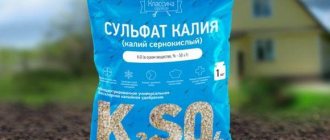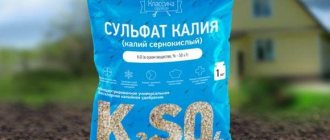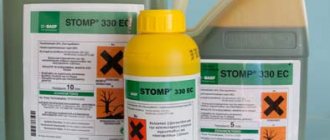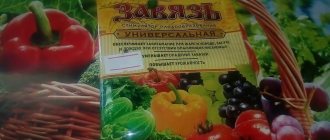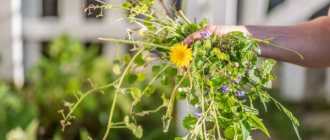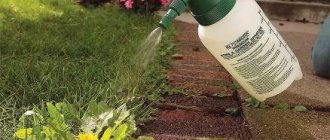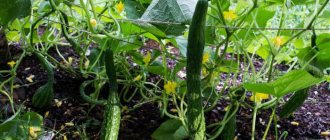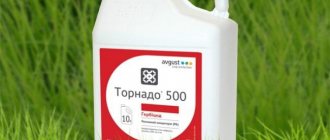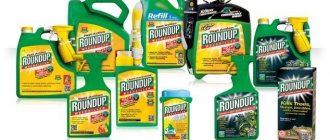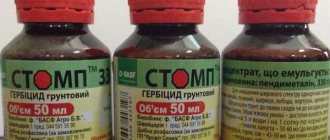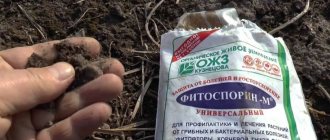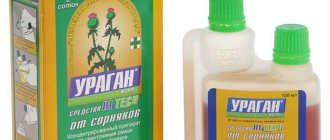Every gardener wants to get a big harvest with minimal effort. To make this dream a reality, agricultural technicians invented a biological product called “Universal Ovary.” The fruit formation stimulator allows you to significantly increase the yield and at the same time reduce the time for fruit ripening. However, we are primarily interested in how safe it is to use these drugs in summer cottages.
Main characteristics of the drug
"Ovary" is a universal drug that contains biological components. Therefore, the substance does not pose a danger to crops and people. The preparation contains many vitamins, micro- and macroelements. It also includes natural acids.
The active component of the product is the sodium salt of gibberellic acid. It is characterized by low toxicity. “Ovary” helps to saturate crops with useful elements that help activate metabolic processes.
By saturating the plant with microelements and energy, it comes out of stress and stops shedding ovaries.
The product promotes the production of growth hormones, which are characterized by physical activity.
other methods
Compliance with the rules for planting and caring for tomatoes allows the plants to form an ovary, and gardeners to get a good harvest.
Soil preparation
Tomatoes prefer soil that contains humus and compost in equal proportions. Additionally, the soil is enriched with potassium sulfate and superphosphate. The soil for tomatoes should remain loose and warm up well.
The first soil preparation is carried out in the fall. The soil is dug up to a depth of 20 cm. Before planting in the spring, the procedure is repeated.
Advice! Tomatoes are planted in the spring, when night frosts have passed and the average air temperature is set at 15°C.
The soil for tomatoes is first disinfected with a solution of iodine or other substances. This way you can avoid the development of tomato diseases that lead to the fall of the ovary.
Loosening the soil is another factor that increases the yield of tomatoes. As a result, soil aeration, moisture penetration and nutrient absorption are improved.
To strengthen the root system, tomatoes are hilled. Thus, additional roots are created, improving the supply of moisture and minerals for the formation of tomato ovaries.
Planting scheme
In a greenhouse, tomatoes should be planted in a certain direction: from east to west. Thus, all seedlings will receive uniform lighting, and in the afternoon there will be no darkening from neighboring plants. As a result, daylight hours for tomatoes increase and the number of ovaries increases.
Advice! Tomatoes are planted in one or more rows.
Up to 0.7 m is left between seedlings. If two rows are equipped, then up to 0.8 m is left between them. Tomatoes can be placed in a checkerboard pattern or along one line.
Another option is combined planting. Low-growing varieties are planted near the walls of the greenhouse, leaving 0.4 m between them. Tall tomatoes, which ripen at a later date, are placed next to the aisle. Thus, plant pollination and ovary development are ensured.
Mulching
Mulching allows you to enrich the soil in the heifer. The surface of the soil is covered with a layer of compost, straw, mown grass or sawdust. This method makes it possible to avoid weed germination.
Important! Mulching is required for any type of tomato planting, especially in greenhouses and greenhouses.
An additional effect is the preservation of soil moisture and the absence of crust on the soil surface. Mulch promotes the development of beneficial microorganisms that turn the top layer of soil into fertile soil for tomatoes.
Mulching the soil is done immediately after planting tomatoes. If a constant temperature has not yet been established, it is better to postpone the procedure. Otherwise, in case of frost, the tomatoes will freeze, which will negatively affect the formation of the ovary.
Stepsoning
Eliminating excess shoots allows tomatoes to direct all their energy to the development of the ovary. Flowers and fruits may appear on the abandoned shoots, but they will not have time to form.
Important! If the region has a short summer, then pinching tomatoes is an important condition for obtaining an ovary.
Excess tomato shoots can be removed already at the seedling stage. After planting in the ground, intensive formation of shoots begins.
The shoots are removed every week. This is done before their length exceeds 2.5 cm. Otherwise, there is a risk of injuring the tomato. Then the tomatoes will direct their vitality to the formation of the ovary.
Advantages and disadvantages
The advantages of Ovary include the following:
- stimulation of fruit appearance even in unfavorable conditions;
- increasing the number of ovaries;
- reduction of ovary abscission;
- acceleration of fruit growth;
- reduction of ripening time by 5-7 days;
- increase in yield by 15-30%;
- improving the taste of fruits.
The product is easy to use and has a safe composition. Therefore, gardeners were unable to identify any significant disadvantages. It should be borne in mind that the stimulator of fruit formation is not able to completely replace pollination by bumblebees and bees.
What are they?
These are drugs that help protect plants from pests and various diseases.
Experts are constantly improving their composition, taking into account the immunity of the tomato, and developing new ones. As a result of this work, a huge selection is formed, which makes it quite problematic to choose the drug you need.
To do this, you need to understand the features of their use. In turn, the compositions are divided into:
- Biological. They include plants, fungi or bacteria.
- Chemical organic. These are phthalimides, morpholines, triazoles.
- Chemical inorganic. Their composition includes sulfur, copper, iron compounds, and salts.
There are also preparations for the following uses:
- For seed treatment.
- Antiseptic and antibiotic for substrates.
- Compositions that are used during the period of active growth.
Other drugs can be divided by use:
- For prevention.
- Strengthening immunity.
- Medicinal. They help in the first few days after the disease.
In addition to drugs for diseases and pests for tomatoes, there are various compositions for plant growth, for pulling seedlings and for pollinating tomatoes in a greenhouse.
How does Ovary work?
Expert opinion
Zarechny Maxim Valerievich
Agronomist with 12 years of experience. Our best country expert.
Ask a Question
The drug includes components that saturate the fruit tissues with nutrients and enhance the stimulating properties.
Under the influence of fruit formation stimulants, a strong activation of metabolism is observed, and the falling of flowers and ovaries is reduced.
See also
Rules for using oak sawdust in gardening, their pros and consRead
At the same time, even unfertilized ovaries begin to grow rapidly, which provokes the appearance of so-called parthenocarpic fruits. They differ from seed fruits in their large size, have a fleshy structure and impeccable quality.
Thanks to the use of the product, it is possible to increase yield parameters by 30% and speed up the ripening process by 5-7 days. In addition, the composition increases the resistance of crops to diseases and helps to obtain a harvest even in unfavorable weather conditions.
For what crops can it be used?
The drug is called “Universal Ovary” - this gives the right to use it for almost all cultivated plants. So, there are positive reviews when used for:
- All types of cabbage;
- Potatoes;
- Greens - cilantro, dill, onion, parsley;
- Strawberries;
- Berry bushes;
- Melons;
- Fruit trees;
- Flower plants and shrubs.
And finally about the features
In conclusion, I note that along with the advantages of use described above, the “Universal Ovary” prevents a number of diseases that most often affect plants and negatively affect productivity. Among them are late blight, macrosporiosis and septoria.
Every gardener wants to get a big harvest with minimal effort. To make this dream a reality, agricultural technicians invented a biological product called “Universal Ovary.” The fruit formation stimulator allows you to significantly increase the yield and at the same time reduce the time for fruit ripening. However, we are primarily interested in how safe it is to use these drugs in summer cottages.
Area of use
The drug "Ovary" can be used for various crops. These include the following:
- cucumbers;
- tomatoes;
- beans;
- potato;
- grape;
- cabbage;
- plum;
- Apple tree;
- pear;
- cherry;
- black and red currants;
- raspberries;
- garden strawberries;
- peas.
From pulling seedlings
Drugs that slow down the growth of seedlings are called retardants. Which are used for watering or spraying. For example, the drug Atlet.
Athlete
Description: also, it improves the quantity of tomato harvest and their quality. Plants treated with it stop growing in height and begin to actively form a root system.
Purpose: its main purpose is to control the growth of seedlings.
Cost of the drug: 11 rubles.
Instructions:
- It is necessary to water (spray) 1 young plant that already has 3 true leaves.
- Watering should be done once or 3 sprays. Use 50 ml of solution.
- In the next 2 sprayings, increase the concentration to 1 ampoule per 0.5 liter of water.
- Carry out the treatment once a week.
Stopprost
Description: is a plant growth regulator (retardant). Increases immunity to pests and diseases, increases productivity.
Purpose: inhibits the growth of seedlings in low light conditions.
Average cost: 14 rubles.
Instructions: dilute 0.5 packets of powder in 5 liters of water. For processing 60 m2. 3 sprays are enough.
Reggae
Description: the drug is a tomato growth regulator. It also activates the development of roots and strengthens the stem.
Purpose: prevents seedlings from stretching in low light conditions.
Average cost: from 10 rubles.
Instructions: in case of preventing overgrowth of tomato seedlings, it is necessary to spray the plants three times:
- 1 in the 3-leaf phase;
- 2 and 3 with an interval of 7 days.
To do this, you need to dilute the solution at the rate of 1 ml of the drug per 1 liter of water.
Instructions for use
Before use, it is recommended to mix the stimulant with water. In this case, you must adhere to the instructions. You can spray plants during the formation of buds and during the flowering period. In this case, 1-3 treatments are required - it all depends on the specific crop.
When using the product, you need to follow these recommendations:
- Tomatoes, peppers, physalis, eggplants need to be processed three times. This is done at the flowering stage of 1, 2, 3 fruit clusters. For 1 liter of soft, settled water, you need to take 2 grams of the substance. For 10 square meters of planting it is worth using 300 milliliters of the substance.
- It is recommended to process zucchini, pumpkin, and cucumbers twice. In this case, 2 grams of the product should be mixed with 1.4 liters of water.
- It is recommended to process raspberries, gooseberries, black, white and red currants twice. This is done during flowering and the formation of a small ovary. For 1 liter you should use 2 grams of the substance.
- Pear, apple, plum and other fruit trees should be sprayed twice. This is done during flowering and at the stage of massive petal fall. For 1 liter of water you should take 2 grams of the product.
It is necessary to process the plantings in the morning or evening. This is recommended to be done in dry and windless weather.
See also
Instructions for use of Etamon, growth stimulant dosage and analoguesRead
Diseases of cucumbers in a greenhouse. White rot of cucumbers. Website "Garden World"
- During fruiting, greenhouse tomatoes, to accelerate the ripening of fruits, can be fed with the following composition: 1 tbsp. l nitrophoska, 1 tsp. l of dry sodium humate powder, diluted in 10 liters of water. For every 1 m2, 5 liters of working solution are consumed.
Nutrients required for greenhouse tomatoes
Tomatoes grown in greenhouses or greenhouses require mineral fertilizers containing:
- potassium; phosphorus; nitrogen.
Let us dwell in more detail on the question of what time and what to feed tomatoes in a greenhouse.
Nitrogen
Nitrogen fertilizers are needed at two main stages of tomato development:
- After transplanting into a greenhouse or greenhouse. After the formation of ovaries on the first two clusters of most tomato bushes.
As mentioned above, if the seedlings are very overgrown, and besides, they were grown in low light conditions, and after transplanting they remain weak and elongated, then after 10 days they can be fed with nitrogen-containing fertilizers. Such root feeding will give a powerful impetus to enhanced growth and development of the root system and the bush itself. After most tomato bushes have formed ovaries on the first two clusters, you can fertilize with nitrogenous fertilizers. At this time, the nitrogen added to the soil will not be used to form green mass, but will be directed to the formation and development of fruits.
Potassium
Tomato is a very quickly developing plant, which for its development requires potassium, which promotes the formation of stems, the setting and development of fruits, the manifestation of varietal taste qualities, as well as a beautiful appearance. Among other things, potassium contributes to the resistance of tomatoes to various diseases. (See Tomato diseases in the greenhouse) Tomatoes have the greatest need for potassium fertilizers during the following periods of development:
- During the opening of the third and fourth true leaves, when the generative organs of the plant are laid down. From the moment the ovaries are formed, until the ripening of the fruit.
Signs of potassium deficiency on tomato leaves If a tomato bush is deficient in potassium, then, as you can see in the photo, the plant “signals” about this:
- curling of the edges of the leaf blade; change in color from deep green to yellowish-bronze; uneven ripening of fruits.
Phosphorus
Phosphorus fertilizers applied to the soil contribute to the resistance of plants to various unfavorable conditions, the development of a strong root system and good fruit set. In addition, phosphorus is involved in the process of absorption of other nutrients by plants, in particular nitrogen. If tomatoes are deficient in phosphorus, then you will be able to see this is based on the following characteristics:
- the leaf blade begins to curl along the main vein; red and purple spots appear on the underside of the leaf; the process of fruit ripening slows down.
Tip: the first fertilizing of tomatoes in a greenhouse can be done while planting seedlings in a permanent place. To do this, add 10-15 g of superphosphate to each prepared well.
Microelements
Table of macro and microelements required for tomatoes. In addition to macroelements, tomatoes need a large number of microelements. According to experienced gardeners, for good fruiting and a high-quality tomato harvest, you need about 20 microelements .
- Video: seminar on growing tomatoes
Tomatoes are a plant that decorates almost any garden plot. These are one of the most delicious and healthy vegetables, which are planted both for seasonal consumption and for preservation for the winter. In the middle zone and southern regions of Russia, tomatoes can be grown in open ground. For example, in the Rostov, Voronezh, Tambov regions there will be no problems, there is enough heat for the full growing season of these plants. But in the Pskov and Leningrad regions (and, especially, to the north), growing tomatoes without shelter is a rather risky undertaking. But even here you can get good harvests in open ground if you comply with certain conditions:
- Early planting of seedlings. Proper application of fertilizers for tomatoes at all stages of growth and development. Use of agrotechnical methods to accelerate ovary and ripening
Tomato seedlings
Obtaining, selection and disinfection of seeds
Seeds for seedlings can be bought at the store. You need to choose well-proven, zoned varieties that have genetic characteristics that are consistently passed on from generation to generation. For example, the following varieties are suitable for growing tomatoes in open ground in the middle zone:
- “Verlioka”, “Katya”, “Arctic”, “Native”, “Nevsky”, “Yamal”, “Far North”, “Apples in the Snow”. They are also recommended for greenhouse cultivation in the northern regions of the country.
For the southern regions there is more choice. Here you can plant nightshades with a long growing season and a larger fruit mass of the final product. This:
- “Fifty”, “Taman”, “Salad Pink”, “High-Peel”, “Shiva”, etc. .
Another way to obtain seeds is to get them from your garden. For this, strong, ripe tomatoes are selected (it is better to let them ripen on the bush, without ripening) and kept on the windowsill until they become soft (rotting should not be allowed).
The prepared tomato is cut in half, the seeds are squeezed into a jar and fermented. To do this, they should be left in the jar for 2-4 days. High-quality seeds will separate from the pulp and settle to the bottom.
The process can be considered complete when the resulting substance begins to release gas bubbles. The last step is washing the seeds with clean water. After this, they are dried and stored in a cool (but not cold) room.
Selection of planting material
Before planting, you should sort the seeds by placing them in a glass of water for 10 minutes and stirring with a wooden stick. Seed material suitable for planting will sink to the bottom, and lightweight specimens will remain on the surface. Some sources advise warming up tomato seeds before planting in order for friendly shoots to appear. The benefit of this procedure is questionable, because heating the seeds at high temperatures can deplete the supply of moisture they contain.
How to “treat” tomato seeds?
Previously, for this purpose, a solution of potassium permanganate (1 g per 0.5 cup of water) was most often used, in which the seeds were kept for 20 minutes, and then thoroughly washed with water. But now the drug KMnO? has practically disappeared from sale, and gardeners use other methods to disinfect seeds:
- For example, aloe juice, into which tomato seeds are placed for one day, and then left to dry without washing.
“Treatment” is necessary, because even the best fertilizers for tomatoes will not help to get a good harvest from diseased plants, and after such treatment, adult bushes are practically not affected by anything.
Soak
The following preparations for stimulating seed germination have become the most popular among amateur gardeners : Epin, Zircon and Guamat . They are good not only because they are growth catalysts for growing tomatoes, feeding their seeds with useful microelements, but they are also environmentally friendly fertilizers of organic origin. The soaking temperature in these preparations should not be lower than 15°, otherwise the effect of the elements on the seeds will be incomplete .
It is best to use a solution with t = 20-22 °C. But it is strictly forbidden to soak tomato seeds in an ash solution . This useful fertilizer will be useful in the next stages of plant growth and development.
Now it will have a depressing effect due to the presence of mineral salts in it. Potassium fertilizers for tomatoes are not used at this stage for the same reason. Tomato seeds need, on average, 18 hours to swell. After this, they are taken out of the water so that they do not suffocate, since during germination they begin to need oxygen.
Germination of seeds
This procedure is simple and quite fast. It is best to place the seed material in well-ironed gauze, which can be moistened with water or a diluted growth stimulant (Epin, for example). They germinate within 1-2 days, the most important thing is not to miss this moment, otherwise roots will grow that will dig into the tissue and get stuck there.
Growing seedlings
It is necessary to attend to this issue in central Russia at the beginning of March. In the northern regions, at this time, seedlings are planted for subsequent transplantation into greenhouses. In the southern regions it is planted in April, sometimes even in May.
But here there is no fundamental need for it; you can plant nightshade seeds directly into the ground.
Soil preparation
First you need to prepare the soil for tomato seedlings. There are many recipes for this mixture. Here is one of the most popular: For 1 part of garden or turf soil (land on which nettles grew in summer is ideal), take 1.5 parts of humus, 1 peat, and 0.5 river sand.
To ensure calcium balance, add 1 cup of crushed eggshells. Note that mineral fertilizers are not needed at this stage. They will be needed later, when it is necessary to feed adult plants for ovaries and fruiting.
Soil treatment
The resulting soil mixture must be steamed. This is done in different ways, from heating the bucket over a fire to the oven.
Security measures
The product belongs to the third class of toxicity. This means that it is considered a moderately hazardous substance. The drug is not capable of causing severe poisoning, but when using it you must follow safety rules. This is especially true for people with diseases of the digestive organs, pathologies of the respiratory system, and allergies.
Expert opinion
Zarechny Maxim Valerievich
Agronomist with 12 years of experience. Our best country expert.
Ask a Question
When using Ovary, it is recommended to wear glasses and protect your respiratory system with a respirator. Be sure to use gloves, a hat, and closed clothing.
To prepare the working solution, you should use a special container. After completing spraying of the plantings, your face and hands should be washed in running water. If the working solution gets on the body, it must be washed off with soap. If the substance penetrates the eyes, they should be rinsed with running water. If the solution enters the body, you must immediately drink several glasses of warm water and take activated charcoal.
The product does not pose a danger to cultivated plants, beneficial insects and small animals. It does not accumulate in plant tissues, and therefore does not lead to the accumulation of harmful substances in fruits. The composition does not cause soil or water pollution.
How to spray tomatoes against late blight?
Oh, this is an insidious disease! No matter how many chemicals and different methods gardeners come up with, the question remains open to this day
The problem is that prevention is much easier to do, but for this it is important to understand the root cause and start working in the fall. When all actions are in vain, you have to resort to spraying
And here everyone decides the degree of danger themselves, giving preference to traditional or industrial drugs. Absolutely, the answer to the question of whether it is necessary to spray tomatoes against late blight will be in the affirmative, but this should be done correctly. All summer residents have long been divided into two camps: one prefers exclusively folk recipes, others prefer radical chemical methods.
Protecting tomatoes from late blight with folk remedies
Let's take a look at the list of the most famous and time-tested recipes for treating plantings:
One of the most gentle methods is table salt. But it is only suitable for the initial stage
As soon as you notice the first spoiled fruits, it is important to remove them along with the foliage as soon as possible. Then dilute a glass of salt in a ten-liter bucket
This is the most environmentally friendly of all that you can spray tomatoes with: you simply create a film or coating of salt from late blight, thereby creating a barrier to the fungus. An interesting solution for spraying tomatoes in a greenhouse is an infusion of garlic against late blight. It turns out that the fungus doesn’t like him either. This is perfect for summers with a lot of precipitation and high humidity as a result. Your task is to crush the heads of garlic and mix them with potassium permanganate: we dilute about one and a half glasses of this goodness in a bucket of water. Up to five times per season every two weeks is the approximate norm. Often, lists of recipes for protecting tomatoes with folk remedies include serum and iodine against late blight. The whey is diluted in half with water and from the beginning of the hottest period, around July, you can safely treat the plantings. If whey is not found, replace it with milk and also dilute it with water, adding 15 drops of iodine. Everything is designed for a bucket of water.
Phytophthora on tomatoes and treatment with chemicals
Before spraying tomatoes with industrial preparations against late blight, it is important to remember one simple truth. Everything in this world adapts and fungus is no exception.
If you solve the problem radically, you will have to purchase several types at once, since the fungus adapts and in the second season the previously purchased chemical may be powerless.
Conventionally, all chemical preparations for the treatment of late blight are divided into biological products and fungicides for tomatoes. The first group is considered a safer option. The point is: you dilute the drug and the bacteria in it begin to actively multiply, and when they get to the affected area, they destroy the fungus.
Therefore, it is worth thinking carefully about whether it is worth fighting late blight with the help of fungicides on tomatoes. Phytophthora fungus is very insidious and it is not a fact that it will be vulnerable, but our health will definitely suffer from large doses of chemicals. Among them, the names that come up most often are Kvardis, Hom, Ditan and Bravo. But no one has canceled the use of the already familiar Bordeaux mixture or copper oxychloride.
What exactly you should use is up to you. But it is always better to prevent a problem than to look for a solution at an already dangerous stage for the crop. And before spraying tomatoes against late blight with chemicals, it is worth trying at the earliest stages to use methods that are gentle and harmless to humans.
womanadvice.ru
Method of action
The fruit formation stimulator “Ovary” acts in a similar way:
- reduces the number of fallen ovaries, increases productivity up to 30%;
- increases commercial qualities - fruit size, sugar content in the pulp;
- reduces the likelihood of fruit spoilage during long-term storage;
- prolongs the flowering process, due to which the number of ovaries increases;
- promotes the growth of green mass of the plant;
- improves immunity;
- increases the adaptive abilities of plants to bad weather conditions;
- reduces the duration of crop development.
The fruit formation stimulator activates the germination of pollen grains and the growth of pollen tubes, increasing the number of ovaries even under unfavorable climate conditions. Replenishes the deficiency of gibberellin in plant cells, activating the formation of fruits in case of impaired fertilization.
